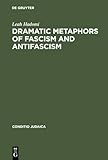Dramatic Metaphors of Fascism and Antifascism / Leah Hadomi.
Material type: TextSeries: Conditio Judaica : Studien und Quellen zur deutsch-jüdischen Literatur- und Kulturgeschichte ; 12Publisher: Tübingen : Max Niemeyer Verlag, [2015]Copyright date: ©1996Edition: Reprint 2014Description: 1 online resource (145 p.)Content type:
TextSeries: Conditio Judaica : Studien und Quellen zur deutsch-jüdischen Literatur- und Kulturgeschichte ; 12Publisher: Tübingen : Max Niemeyer Verlag, [2015]Copyright date: ©1996Edition: Reprint 2014Description: 1 online resource (145 p.)Content type: - 9783484651128
- 9783110941395
- History -- Miscellaneous
- Jewish Studies -- Jewish History -- General Jewish History
- Jews -- Study and teaching -- Jewish History -- General Jewish History
- Literary Studies -- German Literature -- 20th Century
- Literary Studies -- Literary Genres and Media -- Drama, Theater
- Deutsch
- Drama
- Ideologie
- Mythos
- Nationalsozialismus ‹Motiv›
- HISTORY / General
- online - DeGruyter
- Issued also in print.
| Item type | Current library | Call number | URL | Status | Notes | Barcode | |
|---|---|---|---|---|---|---|---|
 eBook
eBook
|
Biblioteca "Angelicum" Pont. Univ. S.Tommaso d'Aquino Nuvola online | online - DeGruyter (Browse shelf(Opens below)) | Online access | Not for loan (Accesso limitato) | Accesso per gli utenti autorizzati / Access for authorized users | (dgr)9783110941395 |
Frontmatter -- Content -- Preface: Attitudes -- Acknowledgements -- CHAPTER I: Introduction -- CHAPTER II: Precedents -- CHAPTER III: Strategies - Contrary and Contradictory -- CHAPTER IV: Germanomania -- CHAPTER V: Conclusion -- BIBLIOGRAPHY -- INDEX -- Index II: Subjects
restricted access online access with authorization star
http://purl.org/coar/access_right/c_16ec
"Yet the dark places are the centre" claims George Steiner in "The Bluebird's Castle". Any attempt to analyze rationally the predominating barbaric phenomenon of the 20th century, namely the Holocaust and its Fascist background, challenges the limits of human understanding. The phenomenon of the Holocaust is a consequence of these "dark places" where again in Steiner's words "we have passed out of the major order and symmetries of Western civilization". A final understanding of the theme is beyond the limits of rationality and may also be viewed in the light of Adorno's "no poetry after Auschwitz". Nevertheless, the need to attempt reflective and creative 'work' on this topic continues. The aim of the book is to study the relationship between ideology and myth as they function diversely in Fascist and Antifascist drama. All the plays discussed are constructed as a paradigmatic constellation between myth and ideology, coordinated by a central and homogeneous political intent. The difference between them lies in their Fascist or Antifascist attitude. The plays analyzed were chosen for the treatment of a common thematic Ur-myth: the post-figuration of the return of the prodigal son and the story of the crucifixion from the New Testament. The 'prodigal cluster' includes plays by Franz Theodor Csokor, Ernst Wiechert and Max Frisch, the 'sacrificial cluster' plays by Otto Erler, Rainer Werner Fassbinder and George Tabori. As an introductory analysis, the theme of the artist and his mission is treated in two plays written in the pre-Nationalsocialist period: "Der Einsame. Ein Menschenuntergang" by Hanns Johst and Bertold Brecht's reaction to this play in "Baal". A final analysis deals with the fusion of mythologems and ideologems as demonstrated in two plays dealing with the New Myth of Germania by Richard Eutinger and Heiner Müller.
Das Ziel dieses Buches besteht darin, die Beziehung zwischen Ideologie und Mythos zu untersuchen und ihre unterschiedliche Funktion im faschistischen und antifaschistischen Drama. Alle besprochenen Dramen sind als ein paradigmatisches Zusammentreffen von Mythos und Ideologie gestaltet, koordiniert durch eine zentrale und homogene politische Idee. Der Unterschied zwischen ihnen liegt in ihrer faschistischen bzw. antifaschistischen Haltung. Die analysierten Dramen wurden wegen der Behandlung eines gemeinsamen thematischen Ur-Mythos ausgewählt: der Nacherzählung der Rückkehr des verlorenen Sohnes und der Geschichte der Kreuzigung aus dem Neuen Testament. Die "verlorene Gruppe" enthält Dramen von Franz Theodor Csokor, Ernst Wiechert und Max Frisch, die "Opfergruppe" Dramen von Otto Erler, Rainer Werner Fassbinder und George Tabori. Als einleitende Analyse wird in zwei Dramen, die in der vor-nationalsozialistischen Epoche geschrieben wurden, das Thema des Künstlers und seiner Mission behandelt: "Der Einsame. Ein Menschenuntergang" von Hanns Johst sowie Bertolt Brechts Reaktion auf dieses Drama in "Baal". Eine abschließende Analyse setzt sich mit der Verschmelzung von Mythologemen und Ideologemen auseinander. Sie wird in zwei Dramen, die sich mit dem Neuen Mythos Germania von Richard Eutinger und Heiner Müller beschäftigen, aufgezeigt.
Issued also in print.
Mode of access: Internet via World Wide Web.
In English.
Description based on online resource; title from PDF title page (publisher's Web site, viewed 28. Feb 2023)


